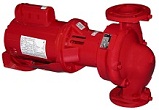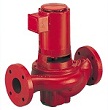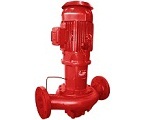| You’ve selected the GPM (gallons per minute) flow rate and the pump head. You corrected the head for the fluid as described in the last few articles. It’s time to select a pump. Why do you select one pump over another and how do you, as the specifying engineer, make sure the submitted pump is remotely close to the one you selected. The R. L. Deppmann Monday Morning Minutes continues Pump Selection today.
Last week we suggested using the B&G inline PL and NRF for those low head coil and secondary pump selections under ½ HP. Today we will look at larger inline pumps and, believe me, there are some pretty big inline pumps available. Before suggesting one inline pump over another I want to talk about bearings quantities and load. If you were purchasing a Ford truck to pull your beautiful 40 foot boat, what would you purchase? A Ford Ranger is available with a hitch and may even be able to pull your boat. A F150 or F250 would provide more power, more stability, and longer life. The Ranger may be able to do the job and may cost less and take up less room in the garage but will you be satisfied with the operation, the reliability, and the repair costs. Pump selection follows a similar argument.
ITT Bell and Gossett (B&G) series 60, 90, and 80 inline pumps cover a wide range of hydraulics. We recommend using the B&G series 60 up to 3 HP. This covers inline capacities up to about 120 GPM at 40 feet of head. The series 60 pump is flexibly coupled so there are 2 bearings in the motor and two bearings in the pump AND it is maintenance free. The series 90 has similar capacities but is direct coupled and requires an OEM motor rather than the standard stock motor of the series 60. Don’t schedule a series 60 and accept a series 90 type pump from our competitors. The series 80 pump and its flexible coupled counterpart, the series 80-SC are inline pumps which are available all the way up to 100 HP! Obviously at 100 HP the pump is no longer supported by the piping in an inline configuration. I recommend you stop using inline pumps after 10 HP. At that point you should go to a base mounted pump if you have the space. That does not mean the larger inline pumps will not work. We sell hundreds of large inline pumps every year but let’s look at some realities. Once you are above 10 HP, the pump weighs over 300 lbs. Imagine you are not the specifier but are now a service contractor or your client’s maintenance person. Imagine this pump is mounted 10 feet in the air. Imagine you and another person standing on a ladder 10 feet in the air and pulling a motor, seal, and impeller that weighs about 250 lbs. out for service. For this reason, the larger series 80 and 80SC pumps are mounted on the floor. Next week we will look at that inline installation on the floor. Click HERE to have a sales engineer contact you for update suggestions to your pump specifications. |
|||
 |
Disclaimer: R. L. Deppmann and it’s affiliates can not be held liable for issues caused by use of the information on this page. While the information comes from many years of experience and can be a valuable tool, it may not take into account special circumstances in your system and we therefore can not take responsibility for actions that result from this information. Please feel free to contact us if you do have any questions.
Archives – Click here for Past Articles



